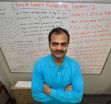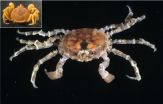(Press-News.org) AUGUSTA, Ga. - The initial motivation was to estimate the age structure of a fruit fly population, the result a fundamental theorem that can help determine the age distribution of essentially any group.
This emerging theorem on stationary populations shows that you can determine the age distribution of a population by looking at how long they still have to live.
The mathematical discovery can help produce data with a wide range of implications, from predicting rates of infectious diseases, such as West Nile virus spread by mosquitoes, to anticipating the health care needs of an aging population.
"The idea is you can't look at an insect and say: How much longer are you going to live?" said Dr. James R. Carey, entomologist at the University of California, Davis. "If you understand the age structure of the population, you can better understand the risks and needs," said Dr. Arni S.R Srinivasa Rao, a mathematical modeler at the Medical College of Georgia at Georgia Regents University. "If there are more children, you need to worry about schools; if there are more older people, you need to worry about health benefits." Rao noted that while many countries, including the United States, have good population data generated by regular surveys, others, including some European and many Third World countries, still don't.
The new theorem is published in the Journal of Mathematical Biology and Notices of the American Mathematical Society.
The work began about a decade ago, when Carey deduced that by keeping tabs on how long a large fruit fly population lived in captivity, he could determine the age structure - how many flies are how old - of the general fruit fly population. It's called Carey's Equality.
Figuring that out without knowing the age of the fruit flies at capture was Carey's eureka moment.
Flash forward to a mathematical demography meeting last year at The Ohio State University Mathematical Biosciences Institute where Carey was explaining his observation and Rao was listening.
"I saw a pattern in what he observed," Rao said, and within 45 minutes, he had put together the complex mathematics behind it, helping prove the relationship, and making it more readily transferrable to diverse populations, from humans to the mosquito population they are now studying. He presented the math to his new colleague the next day.
"We went back a few more steps and said how is this true; what are the biological factors; what are the symmetries; what are the patterns in biology," Rao said.
In fact, putting two graphs - one depicting the usual course of individual fruit flies from birth to death and the other charting how long flies lived after capture -back-to-back creates a symmetrical mountain that starts at the peak of one day of life and trails off at the base at about 60 days of life on either side.
Their theorem can be applied to human and non-humans in stationary populations - meaning the birth and death rate and age composition are stable and similar - such as the fruit fly or more dynamic populations like China.
In terms of broader application beyond age distribution, instead of farmer's guesstimating how many wolves are needed to keep their elk population in an ideal range and vice versa in Montana, they can apply this theorem.
"It's not about how many wolves there are; it's about what is needed to make them both live together," said Rao. "We need to know at what rate wolves are killing elk and how many elk are dying." The age structure of the wolves and elks also yields evidence of how many are in their reproductive years. Taking it to the next step, how much food do the elks need to live, Rao said.
Back to the mosquito, "Understanding age structure in these insect populations is a huge deal worldwide because it's the older mosquitoes that vector the West Nile fever, malaria, yellow fever, and so forth," Carey said.
Biochemical and gene expression studies to collect age data are crude and don't reveal much, and programs to capture, mark, release, then recapture often yield too few recaptures, Carey noted.
INFORMATION:
Toni Baker
Communications Director
Medical College of Georgia
Georgia Regents University
706-721-4421 Office
706-825-6473 Cell
tbaker@gru.edu
New theorem determines the age distribution of populations from fruit flies to humans
2014-10-06
ELSE PRESS RELEASES FROM THIS DATE:
The skin cancer selfie
2014-10-06
WASHINGTON, Oct. 6, 2014— Melanoma is the fifth most common cancer type in the United States, and it's also the deadliest form of skin cancer, causing more than 75 percent of skin-cancer deaths. If caught early enough though, it is almost always curable. Now a camera, capable of taking snapshots of the entire human body and rendering high-resolution images of a patient's skin may help doctors spot cancer early and save lives.
Developed by a team of researchers at Duke University in North Carolina, USA, the "gigapixel whole-body photographic camera" is essentially three ...
Most liver cancer patients do not receive proper care
2014-10-06
Many US patients with liver cancer—even those with early stage disease that can often be cured—do not receive treatment for their disease, according to an analysis of studies published between 1989 and 2013.
Less than one fourth of patients undergo curative treatment, and nearly 50% do not receive any treatment. Elderly, non-Caucasians and patients of low socioeconomic status had lower treatment rates than their counterparts.
"We found the low treatment rates among patients with early stage tumors particularly concerning. Many of these patients currently fail to receive ...
Blood levels of Vitamin D may affect liver cancer prognosis
2014-10-06
Vitamin D deficiency is linked with advanced stages of liver cancer and may be an indicator of a poor prognosis, according to a study of 200 patients with the disease who were followed for an average of 46 weeks.
Blood levels of vitamin D negatively correlated with stages of the disease, and patients with severe vitamin D deficiency had more than a 2-fold increased risk of dying during the study, according to Dr. Oliver Waidmann, senior author of the Alimentary Pharmacology and Therapeutics study.
INFORMATION:
...
Drug-loaded beads may help treat liver cancer
2014-10-06
A new phase 1 safety trial has demonstrated that idarubicin-loaded beads are well tolerated by patients but are toxic to liver cancer cells. Idarubicin is an anthracycline that is currently used to treat leukemias.
Two months into the 21-patient trial, the tumors of 28% of patients had complete responses to the drug, and the tumors of 24% of patients had a partial response. The findings are published in Alimentary Pharmacology and Therapeutics.
INFORMATION:
...
Eating white meat and fish may lower risk of liver cancer
2014-10-06
Eating lots of white meat (such as poultry) or fish may reduce the risk of developing liver cancer by 31% and 22%, respectively, according to a recent analysis of studies published between 1956 and 2013.
Consuming red meat, processed meat, or total meat was not associated with liver cancer risk. The Alimentary Pharmacology and Therapeutics findings suggest that dietary interventions may be a promising approach for preventing liver cancer.
INFORMATION: ...
Oxycodone may be more dangerous than other addictive pain medication
2014-10-06
While all prescription opioids can be abused, oxycodone may be more potent in its ability to promote changes in the brain relevant to addiction.
A new study in the European Journal of Neuroscience revealed greater increases of dopamine in the brain following the delivery of oxycodone compared with morphine. The release of dopamine, a chemical messenger between neurons, is consistently tied with reward and motivation.
The study's investigators say that it is essential to understand how drugs differentially alter brain chemistry if we hope to understand addiction and ...
China's economic boom thwarts its carbon emissions goals
2014-10-06
Efforts to reduce China's carbon dioxide emissions are being offset by the country's rampant economic growth, according to new research from the University of East Anglia (UEA).
Research published today in Nature Climate Change reveals how carbon efficiency has improved in nearly all Chinese provinces. But the country's economic boom has simultaneously led to a growth in CO2-emitting activities such as mining, metal smelting and coal-fired electricity generation – negating any gains.
According to the study, China, the world's largest producer of CO2 emissions, increased ...
Think and act alobally: Health Affairs' September issue
2014-10-06
This issue was supported by the Qatar Foundation and World Innovation Summit for Health (WISH), Hamad Medical Corporation, Imperial College London, and The Commonwealth Fund.
How is accountable care taking shape internationally?
Mark McClellan of the Brookings Institution and coauthors seek to offer a global description of an accountable care system and a mechanism to assess related reforms. They suggest five components for a framework applicable internationally: population, outcomes, metrics and learning, payments and incentives, and coordinated delivery. They also ...
Lizards in the Caribbean -- How geography influences animal evolution
2014-10-06
A new and potentially more revealing way of studying how animal evolution is affected by the geography of climate has been designed by researchers at The University of Nottingham and Harvard University.
The research, published in the prestigious journal, The American Naturalist, uses a new approach to investigate how animals across (interspecific) and within (intraspecific) species change in size along temperature gradients, shedding light on a 150-year-old evolutionary puzzle. Bergmann's rule — the tendency for warm-blooded animal body size to increase in colder environments ...
Invading crabs could threaten life in the Antarctic
2014-10-06
Life on the Antarctic sea floor is under threat from crabs that could invade the area thanks to favorable conditions as a result of global warming, researchers warn.
In a Journal of Biogeography editorial, experts say invasive species degrade marine ecosystems by preying on or outcompeting local species. Early signs of biological invasion are already apparent.
"Biological invasion is a major worry in the Arctic," said lead author Dr. Richard Aronson, "but we should be just as concerned about the Antarctic." Assessing the extent of the problem requires long-term monitoring ...




